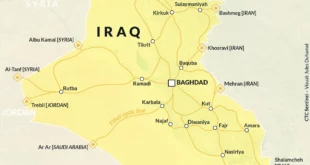 BAGHDAD (Reuters) – Sunnis and Shi’ites made an emotional reach across the sectarian divide on Tuesday, reopening a Baghdad bridge between the two communities closed since a 2005 stampede, the deadliest incident of the war.
BAGHDAD (Reuters) – Sunnis and Shi’ites made an emotional reach across the sectarian divide on Tuesday, reopening a Baghdad bridge between the two communities closed since a 2005 stampede, the deadliest incident of the war.
The Bridge of the Imams connects the Adhamiya and Kadhimiya neighborhoods of Baghdad, named for mediaeval Sunni and Shi’ite holy men whose landmark shrines on opposite sides of the Tigris are surrounded by homes of members of the separate communities.
It had been closed since 2005 when rumors of a suicide bombing panicked thousands of Shi’ites crossing the bridge for a pilgrimage to the Kadhimiya shrine. About one thousand people died in that stampede, clogging the river below with corpses.
But on Tuesday Sunni children from Adhamiya raced to see their Shi’ite friends in Kadhimiya. Women from the two communities met up on the bridge, kissing and hugging each other with joy.
“When the faces met, the lips smiled, hands shook, bodies hugged, the tears flowed out of joy. This is the Iraqi citizen,” said Sheikh Ahmed al-Samaraie, head of Iraq’s Sunni Endowment, which runs Sunni religious offices and mosques in Iraq.
A banner across the bridge read: “The bridge of love and reconciliation between the people of Adhamiya and Kadhimiya.”
Officials said the event was a sign that the sectarian hatred that fueled years of violence in Iraq is ebbing away. The number of Iraqi civilians and U.S. troops killed last month was the lowest monthly toll since the fall of Saddam Hussein.
“This day is a remarkable day, a day of a great Iraq. The day of meeting, love, brotherhood, affinity … The day we proved to the whole world that we are one nation,” Sayyid Salih al-Haidari, Samaraie’s Shi’ite counterpart said in a speech. Delegations accompanying the two officials then went to pray together at a nearby mosque.
Traders and students said the bridge would improve their lives, by cutting out an arduous detour through the city center.
Despite reconciliation between Adhamiya and Kadhimya, concrete blast walls still divide Baghdad districts, many along sectarian lines, making commuting difficult. Frequent bomb attacks still take a deadly toll.
But for many people the main impact of the bridge’s reopening was to help heal old wounds and move on.
Sheikh Ihsan al-Tamimi, whose three sons and a nephew had been kidnapped and killed, had come to bury the hatchet.
“I am here today to show that an Iraqi can forgive a brother Iraqi, even if there is blood between them,” he said.
Volleys of mortar rounds and gunfire had passed over the Tigris River between Kahdimiya and Adhamiya districts for years. Now each side slaughtered a sheep in each other’s honor.
Widad Ahmed, a doctor, was hit in the leg by a bullet on the Adhamiya bank of the Tigris two years ago.
“We came today to forget the wounds of the past,” she said.
 Eurasia Press & News
Eurasia Press & News


